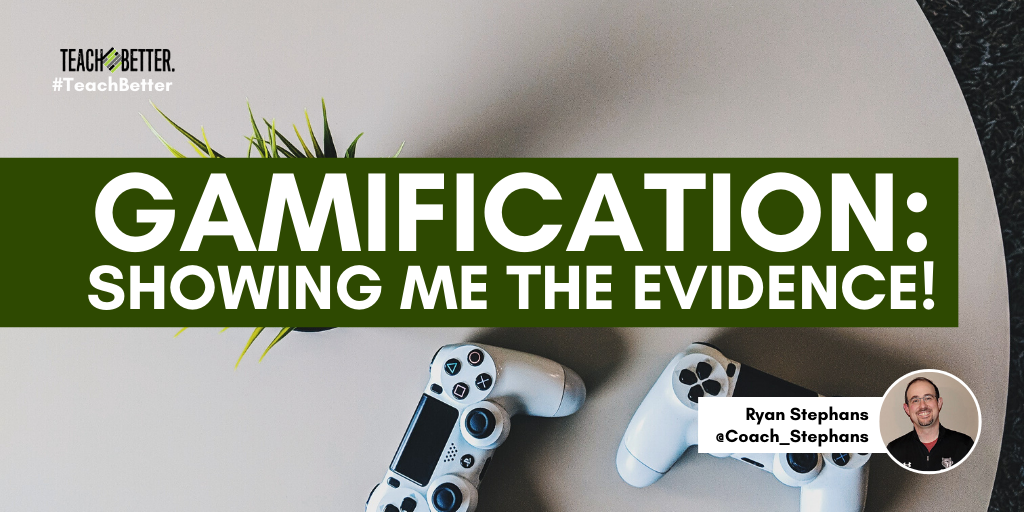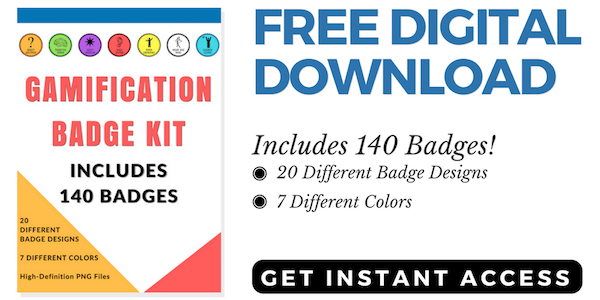TL;DR:
- The difference between playing games and gamification.
- Elements of gamification… that are also best practices of pedagogy.
- Research & evidence that supports using gamification for student success.
As a teacher of a fully-gamified class, I often hear phrases such as, “That’s really cool, but how do you know the system is working?” Most of the time this involves a great conversation about how gamification is simply a layer over my curriculum and pedagogy, not a replacement.
I firmly believe that bad pedagogy will not be saved with a shiny new idea. This goes for most, if not all, new ideas in education. However, very little work has been done to explore the key elements of gamification to show the evidence of why it works. For that, we need data and a clear understanding of how a gamified class operates.
Gamification is More than Games
First and foremost, games work. We knew this from the moment we played Jeopardy or Trashketball for review in class.
Gamification, however, is much more immersive. It takes students on a journey through the content. Gamification requires that they apply skills from both in class and the outside world to solve problems or accomplish tasks.
Gamification takes students on a journey through the content. It requires that they apply skills from both in class and the outside world to solve problems or accomplish tasks. Click To TweetOne of the leading experts on statistics in education is John Hattie. His work entitled Visible Learning details his meta-analyses of 1,200 studies of different influences on student achievement.
Through his work, he found the average effect size to be .40. Effect size measures the difference in achievement between a group with the influence and one without.
He dubbed his finding the “hinge point”. It is the point where we can accurately say that an influence will have a greater impact on student achievement than what would normally be expected over the course of the year.
Hattie does not specifically address gamification in his research. I suspect this is due to an inconsistent definition about what is or is not gamification and a limited availability of teachers implementing it. Even so, we can look at elements of gamification and talk about the impact those influences have on student achievement.
Elements of a Gamified Class
Let’s begin by defining some key elements of a gamified class. According to Kathy Perret, Hattie himself mentioned at a workshop that “the gaming world gets assessment right” because:
- The games know what you know already. (aka Prior Knowledge & Ability)
- They scaffold your learning. (aka Scaffolding)
- They utilize the goldilocks theory placing you at the “just right level.” (aka Teacher Estimates of Achievement)
- They don’t change the level of success. (Which could be considered an element of Mastery Learning)
- They give you deliberate opportunities to practice. (Deliberate Practice)
- They motivate us to spend hours in the pursuit of learning. (aka Deep Motivation & Approach)
- We don’t want to get to the end. We want to keep playing and achieving higher levels. (aka Feedback & Mastery Learning)
We could also add several other components. Problem-solving & decision making are clearly a part of gamified learning. They involve Cognitive Task Analysis, Inquiry-based teaching, & Problem-solving. Cooperative groups, or Cooperative Learning are also cornerstones of gamification.
It is important to note that this list is not exhaustive. The key point here is that, when viewed through the lens of effect size, each is at or above Hattie’s “hinge point” on their own.
The beauty of gamification is that, when done well, it combines all of these elements of effective pedagogy.
[scroll down to keep reading]A Look at the Numbers on Gamification
Once we understand the key elements of a gamified class, we can look at Hattie’s effect sizes for each of these areas. From that we can determine the likelihood that those influences will result in student achievement.
Robert Coe, a professor of education at the University of Durham in England, put together a table of interpretation of effect sizes in 2002. If we combine his work with Hattie’s effect sizes table, we get the following probabilities of improved student achievement using the elements of gamification:
- Prior Ability – effect size: .94. Probability of improved student achievement: 75%
- Scaffolding – effect size: .82. Probability of improved student achievement: 71%
- Teacher Estimates of Achievement – effect size: 1.29. Probability of improved student achievement: 82%
- Mastery Learning – effect size: .57. Probability of improved student achievement: 65%
- Deliberate Practice – effect size: .79. Probability of improved student achievement: 70%
- Deep Motivation & Approach – effect size: .69. Probability of improved student achievement: 69%
- Feedback – effect size: .70. Probability of improved student achievement: 69%
- Cognitive Task Analysis – effect size: 1.29. Probability of improved student achievement: 82%
- Inquiry-Based Teaching – effect size: .40. Probability of improved student achievement: 61%
- Problem-Solving Teaching – effect size: .68. Probability of improved student achievement: 68%
- Cooperative Learning – effect size: .40. Probability of improved student achievement: 61%
Gamification is Evidence-Based Practice
Not all of these elements are present at every moment of every day. But the cumulative effect of these influences should be evident.
It’s clear that a gamified approach incorporating some, if not all, of these elements results in a massive probability of student achievement.
This is the evidence that gamification goes beyond playing games in class. It is a mindset shift that involves deep understanding of student learning.
In gamification, instruction combines some of the greatest influences on student success with an immersive world of learning. This motivates students to continue the journey beyond the immediate effect of assessment. And they might even find it fun.
About Ryan Stephans
Ryan Stephans is a middle school educator with more than a decade of experience in the public schools as a Social Studies teacher. He is a graduate of Kansas State University, with a Bachelor’s degree in Secondary Education, and Emporia State University with a Master’s in History.
Ryan began his teaching in 2005 at the high school level, before leaving for Turner Middle School in Kansas City, Kansas in 2007. He spent eleven years at TMS, the majority of the time teaching 8th grade United States History. In 2013, he was selected as an Abraham Lincoln Fellow by the Horace Mann Corporation. Beginning in 2018, he joined the staff at Summit Trail Middle School in Olathe, Kansas, continuing to teach 8th grade United States History.




